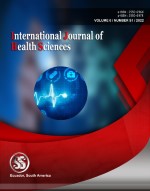IoT and mobile app-based food spoilage alert system
Keywords:
Food monitoring, IoT, temperature sensor, mobile application, alert messagesAbstract
Food is one of the necessities of human life. It is mandatory to maintain a balanced diet with fresh fruits and vegetables to maintain good health conditions. In this fast-forwarded generation, consumers often expect faster delivery of fruits, vegetables, and even food products. For this purpose, the food materials are stored in bulk storage areas. Every type of food requires its environment to stay fresh for a long time. When different types of food materials in enormous amounts are stored in one area, it becomes tougher for the one who manages the storage area to maintain optimum values for all parameters. It also becomes difficult to identify whether the food inside a compartment is fresh or rotten. To help this scenario, this study aims the development an Internet of Things (IoT) system which is capable of monitoring the necessary parameters. This system consists of sensors, a controller, and software. The sensors are directly linked to the food materials that need to be monitored. The nodeMCU module receives and processes the data collected from the sensors. The information gathered is sent to the Blynk mobile application. The collected data is then analyzed or compared to the parameter threshold values.
Downloads
References
D. Lin, C. Juan, and C. Chang, "Managing Food Safety With Pricing, Contracts, and Coordination in Supply Chains," in IEEE Access, vol. 7, pp. 150892-150909, 2019, doi: 10.1109/ACCESS.2019.2946137.
K. Li, Y. Chen, J. Liu, L. Zhang, and X. Mu, "Online Food Delivery Platforms and Restaurants’ Interactions in the Context of the Ban on Using Single-Use Plastics," in IEEE Access, vol. 9, pp. 96210-96220, 2021, doi: 10.1109/ACCESS.2021.3095296.
S. N. Swamy and S. R. Kota, "An Empirical Study on System Level Aspects of IoT (IoT)," in IEEE Access, vol. 8, pp. 188082-188134, 2020, doi: 10.1109/ACCESS.2020.3029847.
W. A. Jabbar et al., "Design and Fabrication of Smart Home With IoT Enabled Automation System," in IEEE Access, vol. 7, pp. 144059-144074, 2019, doi: 10.1109/ACCESS.2019.2942846.
W. A. Jabbar, H. K. Shang, S. N. I. S. Hamid, A. A. Almohammedi, R. M. Ramli and M. A. H. Ali, "IoT-BBMS: IoT-Based Baby Monitoring System for Smart Cradle," in IEEE Access, vol. 7, pp. 93791-93805, 2019, doi: 10.1109/ACCESS.2019.2928481.
A. Romputtal and C. Phongcharoenpanich, "IoT-Linked Integrated NFC and Dual Band UHF/2.45 GHz RFID Reader Antenna Scheme," in IEEE Access, vol. 7, pp. 177832-177843, 2019, doi: 10.1109/ACCESS.2019.2958257
.Y. Yin, T. Nie, and M. Ding, "Temperature Sensor Based on Microbottle Resonator Immersed in Isopropanol," in IEEE Photonics Journal, vol. 13, no. 3, pp. 1-7, June 2021, Art no. 7100807, doi: 10.1109/JPHOT.2021.3081716.
Z. Wang et al., "Fiber Core-Offset Humidity Sensor Based on Graphene Oxide Characteristics," in IEEE Photonics Journal, vol. 13, no. 3, pp. 1-8, June 2021, Art no. 7100608, doi: 10.1109/JPHOT.2021.3083699.
R. Keshavarz and N. Shariati, "High-Sensitivity and Compact Time Domain Soil Moisture Sensor Using Dispersive Phase Shifter for Complex Permittivity Measurement," in IEEE Transactions on Instrumentation and Measurement, vol. 71, pp. 1-10, 2022, Art no. 8001010, doi: 10.1109/TIM.2021.3132367.
X. Zhou et al., "Amplifying the Signal of Metal Oxide Gas Sensors for Low Concentration Gas Detection," in IEEE Sensors Journal, vol. 17, no. 9, pp. 2841-2847, 1 May 1, 2017, doi: 10.1109/JSEN.2017.2678985.
P. Serikul, N. Nakpong, and N. Nakjuatong, "Smart Farm Monitoring via the Blynk IoT Platform: Case Study: Humidity Monitoring and Data Recording," 2018 16th International Conference on ICT and Knowledge Engineering (ICT&KE), 2018, pp. 1-6, doi: 10.1109/ICTKE.2018.8612441.
Rinartha, K., & Suryasa, W. (2017). Comparative study for better result on query suggestion of article searching with MySQL pattern matching and Jaccard similarity. In 2017 5th International Conference on Cyber and IT Service Management (CITSM) (pp. 1-4). IEEE.
Published
How to Cite
Issue
Section
Copyright (c) 2022 International journal of health sciences

This work is licensed under a Creative Commons Attribution-NonCommercial-NoDerivatives 4.0 International License.
Articles published in the International Journal of Health Sciences (IJHS) are available under Creative Commons Attribution Non-Commercial No Derivatives Licence (CC BY-NC-ND 4.0). Authors retain copyright in their work and grant IJHS right of first publication under CC BY-NC-ND 4.0. Users have the right to read, download, copy, distribute, print, search, or link to the full texts of articles in this journal, and to use them for any other lawful purpose.
Articles published in IJHS can be copied, communicated and shared in their published form for non-commercial purposes provided full attribution is given to the author and the journal. Authors are able to enter into separate, additional contractual arrangements for the non-exclusive distribution of the journal's published version of the work (e.g., post it to an institutional repository or publish it in a book), with an acknowledgment of its initial publication in this journal.
This copyright notice applies to articles published in IJHS volumes 4 onwards. Please read about the copyright notices for previous volumes under Journal History.
















